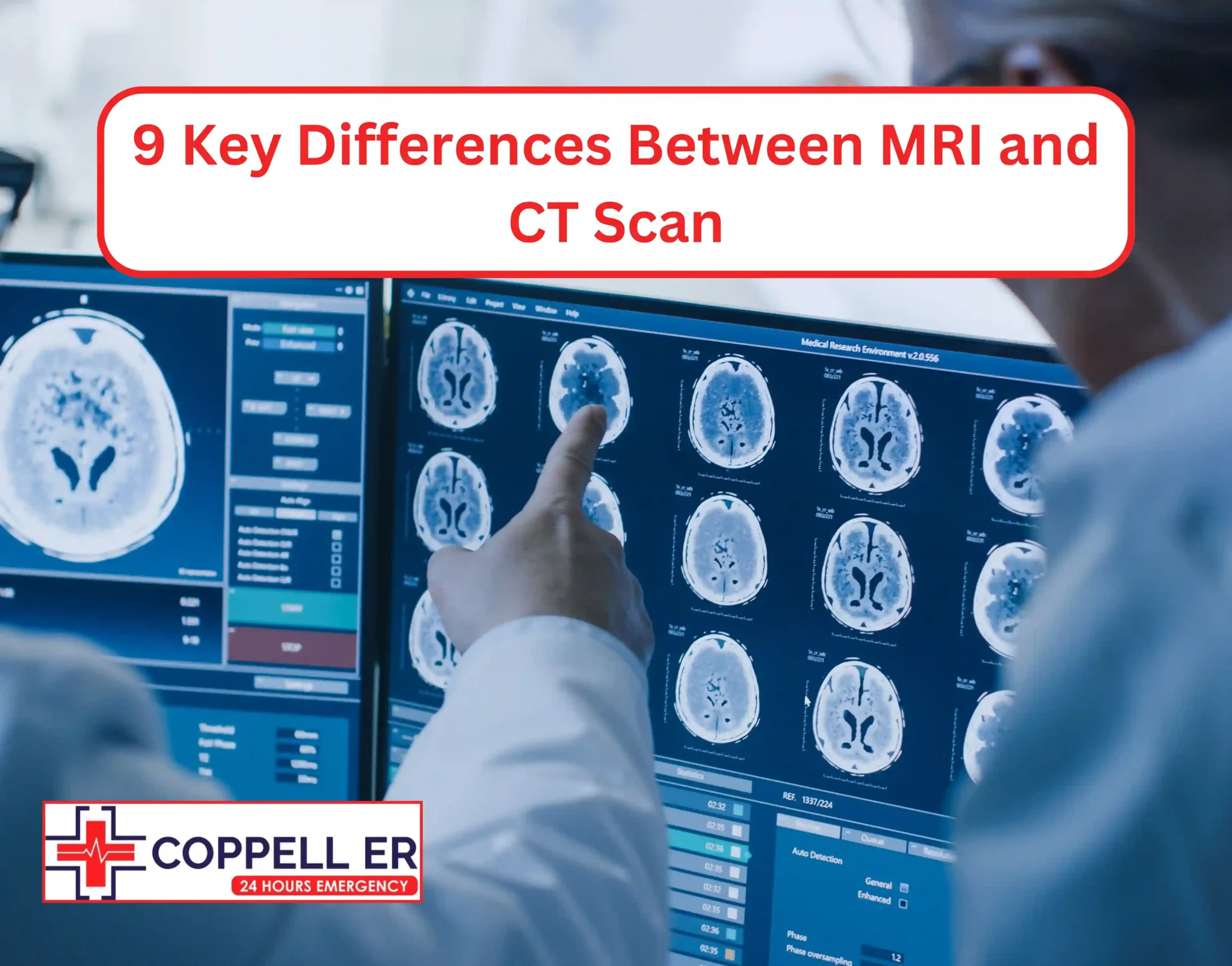X-Ray vs CT Scan: 9 Key Differences You Must Know-ER OF COPPELL

Introduction
When it comes to medical imaging, patients often wonder about the difference between x-ray vs ct scan and which option is best for their condition. Both imaging methods are crucial diagnostic tools in healthcare, but they have different purposes, benefits, and limitations. At ER OF COPPELL, we provide both X-rays and CT scans to ensure fast, accurate diagnoses for emergency and non-emergency medical needs.
1. Understanding X-Rays
X-rays are one of the oldest and most widely used imaging technologies in medicine. They work by passing electromagnetic waves through the body to produce images of bones and certain tissues.
How X-Rays Work
-
X-ray beams pass through soft tissues but are absorbed by denser materials like bones.
-
These variations in absorption create a contrast image on film or digital sensors.
-
Dark areas indicate softer tissues; lighter areas show denser materials.
Common Uses of X-Rays
-
Detecting bone fractures
-
Identifying joint dislocations
-
Spotting pneumonia or lung infections
-
Finding dental issues
-
Detecting bone tumors
Advantages of X-Rays
-
Fast and painless
-
Widely available in most healthcare facilities
-
Low cost compared to other imaging methods
-
Minimal preparation required
2. Understanding CT Scans
CT (Computed Tomography) scans are advanced imaging tests that combine X-ray technology with computer processing to create detailed cross-sectional images of the body.
How CT Scans Work
-
The CT scanner rotates around the body, taking multiple X-ray measurements from different angles.
-
A computer processes these measurements into 3D cross-sectional images.
-
This allows doctors to see both bone and soft tissue structures in great detail.
Common Uses of CT Scans
-
Detecting internal bleeding
-
Identifying organ damage
-
Diagnosing tumors and cancers
-
Evaluating stroke or head injuries
-
Planning surgeries
Advantages of CT Scans
-
Highly detailed images
-
Can capture soft tissues, blood vessels, and bones simultaneously
-
Faster and more accurate than many other imaging techniques
-
Excellent for emergency diagnosis
3. Main Differences Between X-Rays and CT Scans
| Feature | X-Ray | CT Scan |
|---|---|---|
| Image Type | 2D | 3D |
| Details | Basic | Highly Detailed |
| Soft Tissue View | Limited | Excellent |
| Radiation Dose | Low | Higher |
| Time Required | Minutes | Seconds to Minutes |
| Cost | Low | Higher |
| Best For | Bone injuries, chest issues | Complex injuries, organ imaging |
4. When Doctors Recommend X-Rays
-
Bone fractures or breaks – Quick detection and treatment planning.
-
Chest pain or breathing issues – To detect pneumonia, lung collapse, or heart problems.
-
Dental assessments – Checking cavities, jaw alignment, or wisdom tooth positioning.
-
Arthritis or joint concerns – Visualizing bone damage or degeneration.
5. When Doctors Recommend CT Scans
-
Severe trauma or accidents – Checking for internal bleeding and organ damage.
-
Suspected cancers – Locating tumors and determining their size and spread.
-
Stroke symptoms – Detecting blood clots or brain hemorrhage.
-
Complex fractures – Providing detailed 3D images for surgery planning.
-
Infections – Detecting deep infections inside the body.
6. Safety Considerations for Both
Radiation Exposure
-
X-Rays – Minimal radiation exposure.
-
CT Scans – Higher radiation levels, but benefits outweigh risks in urgent cases.
Safety Tips
-
Only get imaging when medically necessary.
-
Inform the doctor if pregnant.
-
Wear protective lead shields when possible.
7. Costs and Accessibility
-
X-Rays – Affordable, available in most urgent care centers and ER facilities like ER OF COPPELL.
-
CT Scans – More expensive, but essential for complex diagnoses.
8. Which One Is Right for You?
The choice between X-ray and CT scan depends on:
-
Your symptoms – Bone injury vs. internal organ concern.
-
Urgency – CT scans provide faster, more detailed emergency insights.
-
Doctor’s advice – Always follow professional recommendations.
9. Why Choose ER OF COPPELL for Imaging Services?
At ER OF COPPELL, we provide:
-
24/7 access to both X-ray and CT scan imaging
-
Board-certified radiologists for accurate readings
-
Fast turnaround times for emergency situations
-
Advanced technology for high-quality images
FAQs About X-Ray vs CT Scan
1. Is a CT scan better than an X-ray?
It depends on the condition. CT scans give more detail, but X-rays are faster and cheaper for simple cases.
2. Does a CT scan use more radiation than an X-ray?
Yes, but it’s safe when medically necessary.
3. Can I eat before a CT scan?
Usually yes, unless you’re having a scan with contrast dye.
4. How long does each procedure take?
X-ray: 5–10 minutes
CT Scan: 5–30 minutes depending on the area scanned.
5. Are there any side effects?
Both are generally safe, but some may have allergic reactions to contrast dye in CT scans.
- Questions and Answers
- Opinion
- Motivational and Inspiring Story
- Technology
- Live and Let live
- Focus
- Geopolitics
- Military-Arms/Equipment
- Security
- Economy
- Beasts of Nations
- Machine Tools-The “Mother Industry”
- Art
- Causes
- Crafts
- Dance
- Drinks
- Film/Movie
- Fitness
- Food
- Games
- Gardening
- Health
- Home
- Literature
- Music
- Networking
- Other
- Party
- Religion
- Shopping
- Sports
- Theater
- Health and Wellness
- News
- Culture

